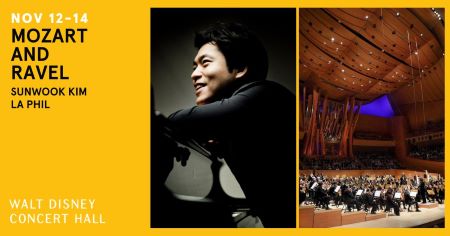RAPTUROUS RAVEL
Of all the entertainment venues in Los Angeles denied us during the COVID years, perhaps the one I’ve missed most is the Disney Concert Hall. So it was a joy to be back there on Saturday, in a packed audience, to experience a splendid program presented by one of the finest philharmonics in the country.
The program was principally Ravel, with the odd inclusion of a Mozart piano concerto. Yet, the interesting takeaway from this juxtaposition of musical eras and styles was to note how composition and orchestration had evolved between the late 18th century and the cusp of the 20th.
Mozart’s Piano Concerto 21 in C major is one of his best known, not least because of the relentless use of its second movement in the 1967 Swedish film, Elvira Madigan. In the sure hands of Sunwook Kim, the piece was given the due strength of the first moment, the delicacy of the second and the sheer playfulness of the third. He gave the same care and beauty of interpretation to his encore, the second movement of Beethoven’s Sonata No. 8.
Maurice Ravel was only twenty and a student at the Paris Conservatory in 1895 when he wrote Menuet Antique for solo piano. It was his first published work and clearly foreshadowed the path his composition would take as he matured. He orchestrated the piece in 1929 and its popularity endures in both versions. It’s constructed in three sections, typical of the minuet form, a form he returns to in a section of his Tombeau de Couperin.
The title, Le Tombeau de Couperin, suggests that Ravel was devoting this piece to the memory of the great Baroque composer, François Couperin. In fact, his intention was to honor the style of the Baroque keyboard suite which is reflected in the six part structure of a traditional dance suite of that era. Each part of Ravel’s suite is dedicated to a friend lost in World War I.
Quite apart from the overwhelming beauty of his compositions, it’s impossible to undervalue, or to underestimate Ravel’s genius for orchestration, an art he studied with Faure. His orchestrations have the clear transparency of pure amber. At their most subtle, they soothe and warm the listener, at their most bombastic, they are all the passionate grandeur that a symphony orchestra can offer. The critic Alexis Roland-Manuel wrote, “In reality he is, with Stravinsky, the one man in the world who best knows the weight of a trombone-note, the harmonics of a cello or a pp tam-tam in the relationships of one orchestral group to another.”
Nowhere is this more evident than in his most popular Bolero, one of his last compositions before illness obliged him to retire. This not only a masterpiece of orchestration, but perhaps a masterclass in how to orchestrate. At the conclusion, the entire audience rose to a deserved standing ovation. I add that snare drummer Matthew Howard was singled out for well merited recognition during the calls. He begins the piece almost inaudibly setting tempo against plucked strings, and must maintain this tempo in increasing volume until the fortississimo crescendo of the finale – 430 bars in total!
The conductor of this program, the world renowned Matthias Pintscher must be praised without reservation for his perfect interpretation of every work on the program. Never ostentatious in his approach, he gently coaxes the orchestra with an attitude suggesting joyful satisfaction at what he hears. This joy is transmitted unfiltered to the listener.
A greatly satisfying program and a wonderful welcome back to life at the Disney Hall.
Los Angeles Philharmonic
Matthias Pintscher, conductor
Sunwook Kim, piano
Disney Hall in Los Angeles
reviewed November 14, 2021

